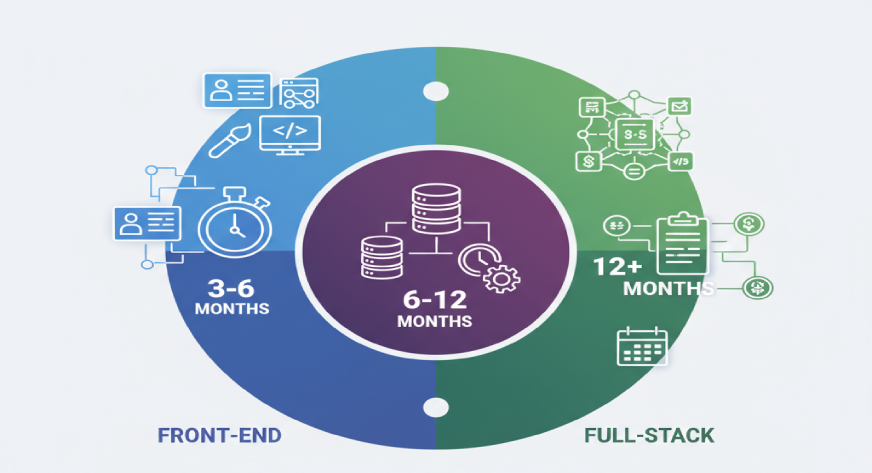How Many Days Takes To Learn Web Development?

Learning the basics of web development usually takes 3 to 6 months with consistent practice, but becoming proficient and job-ready can take 6 months to 1 year, depending on your learning speed and dedication.
Learning web development is exciting, but one of the first questions beginners ask is, “How long will it take to become proficient?” The answer depends on your learning approach, daily commitment, and goals. Whether you want to build personal websites, freelance, or start a career in tech, understanding how long it typically takes helps set realistic expectations and plan effectively.
Learning Stages and Typical Duration of Web Development
Breaking web development into stages makes the process more manageable:
Basics of HTML, CSS, and JavaScript: 2–4 weeks
- Learn the structure of web pages, styling, and basic interactivity.
- Build a personal website or a small landing page for practice.
Intermediate Skills and Frameworks: 1–3 months
- Front-end frameworks like React, Angular, or Vue.
- Back-end basics like Node.js, Express, or databases.
- Example project: A simple blog or portfolio website.
Projects & Portfolio Building: 1–2 months
- Apply skills in real-world projects.
- Examples include small e-commerce sites or interactive dashboards.
Advanced Skills (APIs, Databases, Deployment): 1–2 months
- Learn to integrate third-party APIs, secure web apps, and deploy websites.
- Example: Build a small online store with payment integration.
Also Read , Best Website Frameworks in 2025
Front-End vs Back-End vs Full-Stack Learning Time

Understanding the different learning paths helps plan your time:
- Front-End: Focuses on user interfaces and visuals. You can start building small websites in 1–2 months with consistent practice.
- Back-End: Involves server-side programming and databases. Requires more time to understand logic, APIs, and server management. 2–4 months is typical for basics.
- Full-Stack: Combines front-end and back-end skills. It’s the most time-intensive but highly rewarding for career prospects. 6–9 months or more may be needed.
Example: A front-end developer could quickly create a portfolio website, while a full-stack developer can build a fully functional e-commerce platform with product management and payment features.
How Practice and Projects Influence Learning?
Learning web development is far more effective when you actively build things rather than only reading or watching tutorials. Practice turns theory into real skills and helps you retain information better.
- Build Real Projects: Start with small websites or web apps. For instance, creating a personal portfolio site or a simple to-do app helps you apply HTML, CSS, and JavaScript skills. Each project teaches something new and gives you tangible results to show.
- Experiment and Iterate: Don’t be afraid to try new ideas. Tweak designs, add animations, or connect an API to see how changes affect the website. Experimenting like this deepens your understanding.
- Solve Challenges: Participate in coding challenges on platforms like HackerRank, LeetCode, or freeCodeCamp. These exercises improve problem-solving skills, which are crucial for web development.
- Document Your Work: Keep track of your projects in a GitHub portfolio. This not only shows progress but also gives you a reference to revisit and learn from mistakes.
Example: If you’re learning JavaScript, try building a small quiz app. Each question, timer, and score calculation reinforces concepts like variables, functions, loops, and event handling.
Also Read, 10 Stages of Web Development you should Know!
Tips To Learn Web Development Faster

Efficiency matters, especially if you want to become job-ready or launch projects quickly. Here are practical tips to speed up your learning:
- Consistent Daily Practice: Even 1–2 hours every day is more effective than occasional long sessions. Consistency keeps your memory fresh and reinforces coding habits.
- Work on Real Problems: Build projects that solve actual problems, like a personal blog, a small e-commerce store, or a local business website. Real-world projects teach more than abstract exercises
- Use Interactive Tools: Platforms like CodePen, Replit, or Figma for front-end prototyping allow you to see immediate results. This hands-on approach strengthens your learning.
- Join a Community: Forums, Discord groups, or online study circles provide guidance, motivation, and solutions when you get stuck. Peer feedback accelerates learning.
- Break Down Complex Topics: For advanced subjects like APIs, databases, or React, break concepts into smaller steps and practice each step separately. Then combine them into a full project.
Example: Instead of spending a week reading about APIs, build a weather app that fetches real-time weather data. You’ll learn API requests, JSON handling, and dynamic rendering faster than reading theory alone.
Final Learning
The time it takes to learn web development varies depending on your focus, learning method, and dedication. Front-end basics can be learned in a few weeks, while full-stack mastery may take several months. By setting realistic goals, practicing consistently, and building projects, anyone can gain the skills needed to create functional, attractive websites.
Cheval-Rise by Webworks Co. offers practical learning resources, project templates, and guidance to help aspiring developers learn web development efficiently while building a strong portfolio.
Frequently Asked Questions
Q1. Can I learn web development on my own?
Yes, you can learn web development on your own using online courses, tutorials, and practice projects. Consistent learning and hands-on coding are key to mastering it.
Q2. Can I learn frontend in 3 months?
Yes, you can learn the basics of frontend development in 3 months if you study regularly and practice HTML, CSS, and JavaScript.
Q3. Will AI replace Web Developer?
AI will not replace web developers but will assist them by automating repetitive tasks. Human creativity, problem-solving, and design skills will still be essential.
